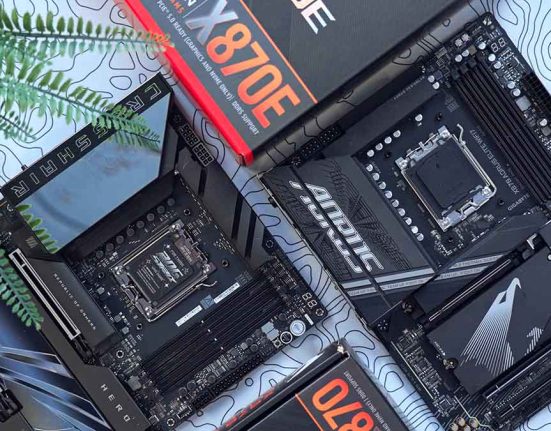The Gigabyte AORUS RTX 5070 Ti MASTER graphics card is one of multiple non-MSRP (manufacturer suggested retail price) GPUs launched as part of the RTX 5000 range. The MSRP cards have already been officially revealed, but the main makeup of the cards on offer don’t sit at MSRP, with cards like the AORUS MASTER variant sitting at $200-$300 more than the $749 price point NVIDIA announced at CES. Regardless of the pricing, most builders are more concerned with how this card holds up compared to the previous generation model. That’s why we’ve put the Gigabyte AORUS MASTER variant of the RTX 5070 Ti through its paces with plenty of benchmarking.
The AORUS MASTER version of the RTX 5070 Ti is one of Gigabyte’s most potent options. It offers enhanced clock speeds and a triple-fan shroud designed to keep thermals to a minimum. Arguably, this makes the higher price of this non-MSRP model easier to swallow, especially if you’re building a beefier system. However, whether this card will be easy to secure amongst the mass of options available is another question entirely because, as we’ve seen with the RTX 5080 launch, stocking isn’t great.
However, despite our concerns about the RTX 5070 Ti, NVIDIA’s Blackwell architecture is incredibly solid, offering noticeable performance improvements to rasterised and ray-traced gameplay. Additionally, NVIDIA’s DLSS technology and Frame Generation continue to offer excellent uplifts in supported titles, with Blackwell going a step further with Multi Frame Gen.
In this review article, we’ve examined the specs, design, architecture, and performance of the Gigabyte AORUS RTX 5070 Ti MASTER graphics card to determine whether it’s worth your hard-earned cash.
Specification
The RTX 5070 Ti is a 16GB graphics card utilising GDDR7 VRAM. It would have been great to see more VRAM on the RTX 5080 and 5070 Ti, as this would open up more options for those building a workstation system. However, 16GB of VRAM will suffice for most games at 4K and 1440p. On paper, the rest of the specs versus the previous generation’s RTX 4070 Ti SUPER are fairly similar. This card sits on a 256-bit memory bus, a similar MSRP of $749.99, while the core counts have been bumped up slightly.

The power draw on the RTX 5070 is slightly higher than the RTX 4070 Ti SUPER at 300W versus 285W. This won’t necessarily mean you’ll need to buy a new power supply, but those on the cusp of their wattage may need to consider securing an upgrade. The other main point of note that’s changed is the VRAM spec. The RTX 4070 Ti SUPER uses GDDR6X VRAM, while the RTX 5070 Ti uses GDDR7. This generation of bandwidth requires PCI-E 5.0, which means those of you who have secured PCI-E 5.0 compatible motherboards in the past few years won’t need to upgrade.
| Key Specs | RTX 5080 | RTX 5070 Ti | RTX 4070 Ti SUPER |
|---|---|---|---|
| Video Memory | 16GB GDDR7 | 16GB GDDR7 | 16GB GDDR6X |
| Memory Bus | 256-bit | 256-bit | 256-bit |
| Base Clock Speed | 2.29GHz | 2.3GHz | 2.34GHz |
| Boost Clock Speed | 2.61GHz | TBD | 2.61GHz |
| CUDA Cores | 10752 | 8960 | 8448 |
| RT Cores | 88 | 70 | 66 |
| Tensor Cores | 336 | 280 | 264 |
| Power Consumption | 360W | 300W | 285W |
| MSRP | $999.99 | $749.99 | $799.99 |
Last but not least, as we’ve mentioned in our other reviews, one of the other big changes that has arrived with the RTX 5000 series is AI TOPS performance. Essentially, this is what powers DLSS and Frame Generation. The RTX 50-series reaches new heights when it comes to AI capabilities, which is why DLSS 4 and its primary features are restricted to RTX 5000 only.
Design
The Gigabyte AORUS RTX 5070 Ti MASTER is one of the flashier cards on the market. This triple-fan 3-slot GPU adorns a black shroud with plenty of RGB lighting. The primary purpose of this card is to remain cool, hence its large heatsink. This card utilises Gigabyte’s renowned WINDFORCE cooling system, ensuring that thermals remain low even under load. Each fan offers ample airflow and pressure without compromising noise levels, so the AORUS MASTER will remain quiet even during more challenging workloads.

Regarding the RGB lighting, Gigabyte has loaded this card with plenty of LEDs so that you can showcase any RGB effects across your build. There are two main areas that house RGB LEDs. The first is the ring of lights around each of the fans. Once the card is powered on, the LEDs create a halo-like effect, which can be customised using the Gigabyte Control Center software.

The second area is the top of the card. You’ll find a small strip that spans the entire length of the card, which synchronises with the rest of the lighting on the card. Towards the top right of the GPU, the ‘AORUS’ text also lights up, providing another element of RGB to showcase. I like that Gigabyte has provided RGB effects that are visible regardless of how the card is mounted.
Architecture
The latest iteration of DLSS, DLSS 4.0, is launching alongside all of the RTX 5000-series graphics cards. NVIDIA has continued to refine its AI-upscaling technology, continually reducing performance overhead when enabled within your favourite games. However, the big leap with DLSS 4 is the introduction of Multi Frame Gen. We’ve further broken down this tech in our other 50-series content, but essentially, Multi Frame Gen makes your game noticeably smoother.
It does this by rendering additional frames using AI next to rasterised frames. This makes your favourite titles far less choppy and significantly hikes up the framerate, contributing to an overall buttery smooth experience. Enabled with DLSS, you can enjoy lower performance overhead with minimal drawbacks.

It is worth noting that Multi Frame Gen isn’t without its caveats. If you’ve read our other RTX 5000 content, you’ll be aware that NVIDIA has received a fair amount of criticism for their Multi Frame Gen technology, with various reviewers calling it ‘Fake Frames’. While I don’t believe this is entirely true, I can appreciate the sentiment of this statement, as the frames generated by Multi Frame Gen don’t offer any tangible performance bonus besides making things look smoother, similar to how AMD’s Fluid Motion Frame technology works.
Additionally, it’s worth noting that Multi Frame Gen does cause system latency issues. Across our benchmarks, we noticed that certain games were worse than others. For example, Cyberpunk 2077 saw a latency result of 16ms, which was pretty noticeable, but in Hogwarts Legacy, latency sat at 2ms, which didn’t really impact gameplay. With this in mind, it will be worth leaving Multi Frame Gen switched off in titles where responsiveness is key.
Performance
As always, all of our benchmarking and testing is done by our in-house benchmarker, Harry Coleman, who has worked tirelessly to gather all the data needed for our RTX 5000 series content. The RTX 5070 Ti and a range of competitor graphics cards have been tested in our primary benchmarking system, which uses an AMD Ryzen 7 9800X3D to provide the best framerates possible across all of the titles we tested. The games featured in this benchmarking section provide a mix of AAA games and modern Esports titles to see how the RTX 5070 Ti holds up in various games.
Cyberpunk 2077
Settings: 4K, Shadow Quality High, Indirect Lighting High, Reflections High, Crowd Density High, Particle Quality High, Volumetric Lighting High, Motion Blur off, GTAO Quality High, Grass Quality High, Contact Shadows High VSync Off, DLSS: On/Off, Ray Tracing: On/Off, Textures: High
Our first benchmark is Cyberpunk 2077 at 4K high, rasterised gameplay only. The RTX 5070 Ti offered a good baseline result in this benchmark with an 80FPS average, compared to the RTX 5070 Ti, which sits at 62FPS. This is a significant jump at 4K, which may put the 5070 Ti in a better market position, targeted as a 4K card if the rest of our benchmarks follow suit.
It’s also worth noting that the RTX 5070 Ti beat out the previous generation’s RX 7900 XTX in this run, a 24GB graphics card. This clearly shows that VRAM isn’t everything at high resolutions.

After we switched on DLSS, Frame Gen and ray tracing, the Gigabyte AORUS RTX 5070 Ti MASTER offered a noticeable improvement up to 93FPS, which is nearly 15FPS more than the rasterised benchmark. Ray tracing impacts framerates here, so Frame Gen has been added to supplement performance. The RTX 4070 Ti SUPER in this run didn’t sit particularly far behind, offering a very reasonable 83FPS, just 10FPS less than the RTX 5070 Ti.

Alan Wake II
Settings: 4K, Post-Processing High, Texture Resolution High, Texture Filtering High, Volumetric Lighting High, Global Illumination Quality High, Shadow Detail High, Terrain Quality High, Ray-Tracing: Enabled, Ray Tracing Preset High, DLSS: On/Off, Frame Generation: On/Off
In Alan Wake 2 at 4K with rasterised gameplay, the RTX 5070 Ti struggled, outputting an average of 51FPS. Unfortunately, this game isn’t optimised for pure rasterised gameplay, so even cards like the RTX 5090 couldn’t cope entirely. If we look at the RTX 4070 Ti SUPER results, framerates are even worse, with this previous generation card sitting at 45FPS.

With DLSS, ray tracing and Frame Generation enabled the overall performance isn’t massively better. While visual fidelity in the game has significantly increased, Alan Wake 2 is again proving to be one of the most complex titles to run at 4K, costing gamers plenty of frames. It’s worth considering dumbing down the settings in this title to enjoy higher frames.

Hogwarts Legacy
Settings: 4K Effects High, Material High, Fog High, Sky High, Foliage High, Post Process High, Shadows High, Textures High, View Distance High, Population High, Anti Aliasing TAA High, Windowed Fullscreen
In Hogwarts Legacy at 4K, the RTX 5070 Ti offered a decent 88FPS, versus the RTX 4070 Ti SUPER, which hovered around 72FPS. Across the board, we’re seeing a decent uplift in performance at 4K, which is excellent despite how similar these cards are on paper. In this benchmark, the RTX 5070 Ti gets beaten out by the RX 7900 XTX, which isn’t a huge surprise considering how much VRAM it has.

Once we switched on DLSS, performance was strengthened across the board. The RTX 5070 Ti sits in between the RX 7900 XTX and RTX 4080 with an average framerate of 122FPS. This is considerably stronger than the rasterised gameplay, with DLSS providing a 40FPS bump at 4K. Unfortunately, the RTX 4070 Ti SUPER isn’t quite able to catch up, hovering around 107FPS in this title.

Marvel Rivals
Settings: 4K, Graphics Quality High, Global Illumination Lumen GI- High Quality, Reflection Quality Screen Space Reflections, Model Detail High, Post-Processing High, Shadow Detail High, DLSS On/Off, Frame Gen On/Off
Dropping the resolution to 1440p in the hit Esports title Marvel Rivals, the RTX 5070 Ti reached 140FPS in this benchmarking run, which is pretty impressive despite being a rasterised benchmark. The RTX 4070 Ti SUPER offered somewhat similar performance with a 128FPS average. High framerates are essential in this title, so the RTX 5070 Ti is the more favourable of the two, especially for those with high refresh rate displays.

After we switched on DLSS and Frame Gen, the RTX 5070 Ti’s performance skyrocketed, with this card sitting at a healthy 257FPS. However, the RTX 4070 Ti SUPER is pretty close, offering 234 frames on average. Ultimately, at framerates this high, the performance difference isn’t going to be particularly visible. However, it’s great that the RTX 5070 Ti still offers a decent improvement over the RTX 4070 Ti SUPER at 1440p.

COD Black Ops 6
Settings: 4K, Graphics Preset Custom, Texture Resolution High, Depth of Field On, Detail Quality High, Particle Resolution High, Shader Quality High, Shadow Quality High, Screen Space Shadows High, DLSS On/Off, Frame Gen On/Off
In COD Black Ops 6 Zombies at 1440p high, the RTX 5070 Ti outputs a solid average framerate of 147FPS, followed by the RTX 4070 Ti SUPER sitting at 141FPS. This game is relatively well-optimised, so there isn’t a massive gap between each card we’ve tested. Unfortunately, DLSS doesn’t do much to improve the standings either, so it will be better to play this title natively to avoid latency or visual fidelity loss.

Apex Legends
Settings: 1440p, Anti-aliasing TSAA, Texture Filtering 8X, Model Detail High, VSync Disabled, Effects High, Ambient Occlusion Quality High
Our penultimate benchmarking run was Apex Legends, maintaining the resolution of 1440p. Unsurprisingly, the RTX 5070 Ti in this title maxed out the framerate. Despite unlocking the FPS, Apex Legends has a cap of 300FPS, and the RTX 5070 Ti sits at 298FPS, so there’s not much more to be gained here. The RTX 4070 Ti SUPER loses out by about 8FPS in this benchmark, but again, at framerates this high, it doesn’t hugely matter.

Fortnite
Settings: 1080p, Competitive, View Distance Far, FPS Unlimited, VSync Off, Anti-Aliasing TAA, Shadows Off, Reflections Off, Textures Low
Our last benchmark title is the hit battle royale Fortnite, where we dialled the resolution down to 1080p and the settings to low. This benchmark gives us an idea of where each generation lands, but ultimately, most gamers won’t be playing Fortnite at 1080p with an RTX 5070 Ti. The RTX 5070 Ti in this particular benchmark offered up 405FPS, which is oddly weaker than the RTX 4070 Ti SUPER at 433FPS. This could be down to drivers or other factors, but we’re not worried that the RTX 5070 Ti will struggle purely based on how ridiculous the results are at 1080p.

Conclusion
Gigabyte AORUS RTX 5070 Ti MASTER
Product Name: AORUS RTX 5070 Ti MASTER
Brand: Gigabyte
-
Features
-
Design
-
Performance
-
Value For Money
Summary
After analysing the specs, design, architecture, and performance, is the Gigabyte AORUS RTX 5070 Ti MASTER truly worth considering? Honestly, it depends. If you’re looking for a flashy 4K-capable graphics card that offers solid thermals and ample RGB lighting, then the AORUS MASTER variant is definitely worth considering.
However, if you’re a builder keeping your eyes out for that all-important MSRP price point, the AORUS RTX 5070 Ti MASTER isn’t for you. This card is expensive and geared towards enthusiasts with plenty of additional cash. Despite this being one of the pricier RTX 5070 Ti models, I feel it offers a stronger value proposition than some of the other models due to its thermal design and aesthetic. But we can understand that its higher price point won’t appeal to everyone looking to pick up an RTX 5070 Ti.
Pros
✅ Vibrant RGB lighting
✅ Excellent thermals
✅ Sturdy and robust design
Cons
❌ Cumbersome design
❌ More expensive than MSRP
❌ Could do with more VRAM


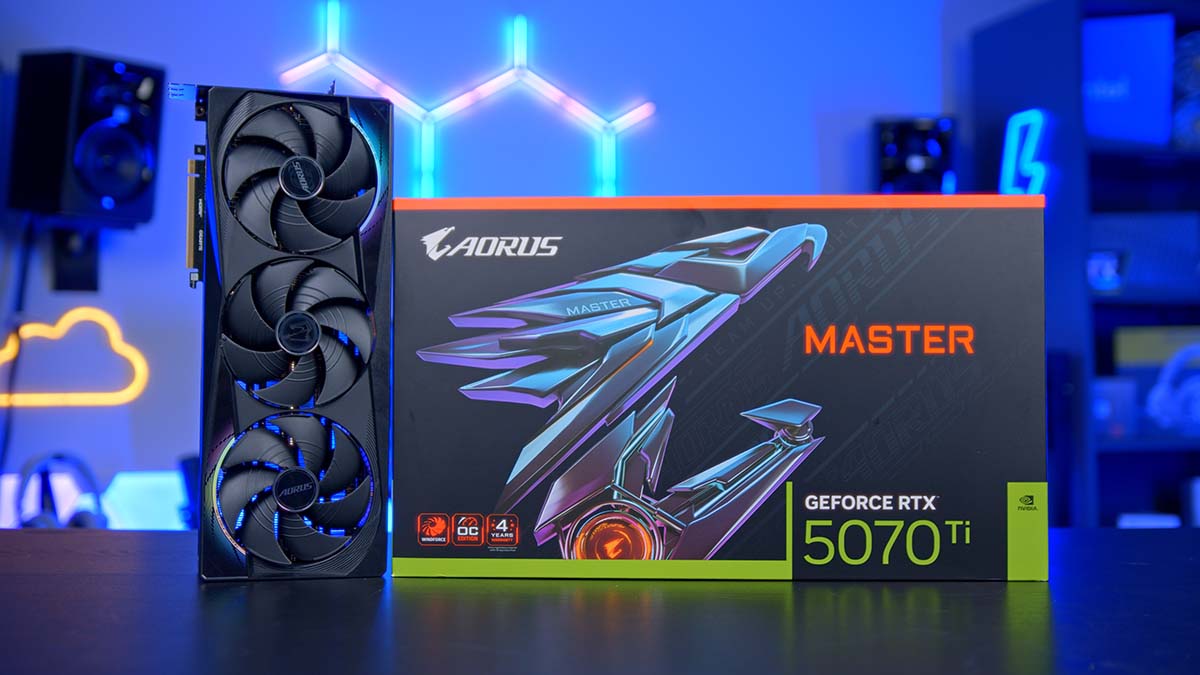
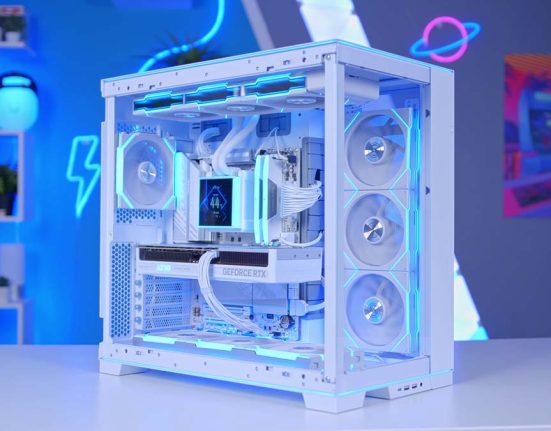
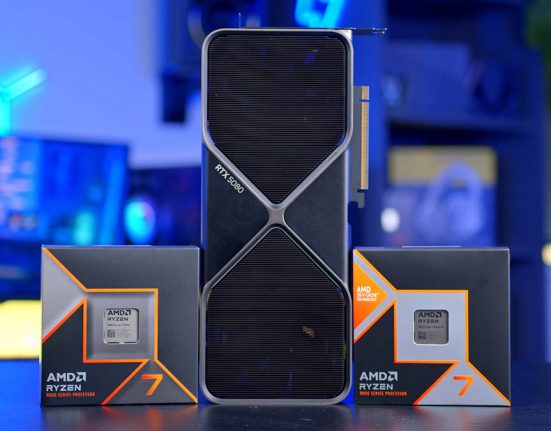
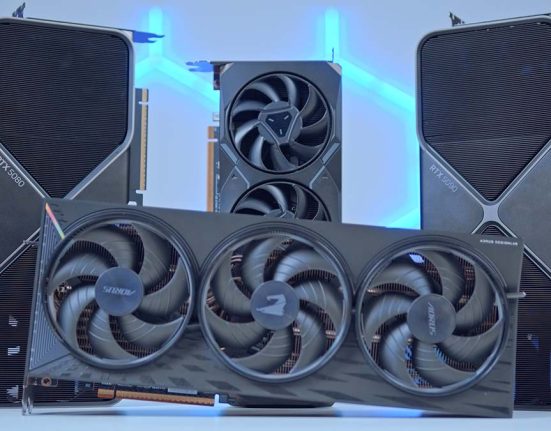
![MPI_[DP055] SAMA V60 + 9070 Build Montage](https://geekawhat.com/wp-content/uploads/2025/12/FI_DP055-SAMA-V60-9070-551x431.jpg)
